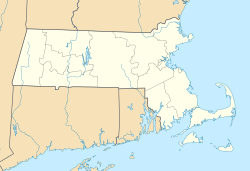Nashawannuck Mills Historic District facts for kids
Quick facts for kids |
|
|
Nashawannuck Mills Historic District
|
|
 |
|
| Location | 1–15 Cottage Street, Easthampton, Massachusetts |
|---|---|
| Area | 4.4 acres (1.8 ha) |
| Built | 1848 |
| NRHP reference No. | 15000001 |
| Added to NRHP | February 12, 2015 |
The Nashawannuck Mills Historic District is a cool historical area in Easthampton, Massachusetts. It's a group of old factory buildings on Cottage Street. Most of these brick buildings were built between 1848 and 1870. They were used for making things until 1970!
The very first building was a button factory. It was started by a man named Samuel Williston. These factories used power from a dam on Bound Brook. Over time, the factories grew. They became famous for making elastic fabrics. These fabrics were used for things like suspenders and webbing. The mills were super important for Easthampton's economy for a long time. This historic district was added to the National Register of Historic Places in 2015.
How the Mills Started
Samuel Williston was born in Easthampton. He began making buttons from his home in 1826. This was a "cottage industry," meaning he worked from home.
From Buttons to Suspenders
In 1847, Samuel Williston and his business partners opened a button factory. It was on Union Street. They built a dam on Bound Brook to get power for their machines. Later, Cottage Street was built over this dam.
Samuel Williston eventually sold his button business. In 1850, he started a new company. It made suspenders! At first, it was called the Williston Elastic Suspender Company. Later, it changed its name to the Nashawannuck Manufacturing Company. This company built Building 10, which is the oldest part of the factory complex.
Growing the Business
The company was very successful. By 1865, it was the biggest employer in Easthampton. Samuel Williston kept expanding his businesses. He started making elastic webbing. He also made rubber parts for shoes. He even used special patent rights for the Goodyear rubber process.
In 1862, he started building another factory next door. In 1912, these two businesses joined together. Their factory buildings were connected. In 1955, Hurricane Diane caused big floods. The factories were damaged. The dam needed repairs, and one building had to be rebuilt.
What Happened Next
The elastic fabric business closed down in 1970. After that, other companies used parts of the mill complex. One side of the complex was given to Riverside Industries (RSI). RSI is a non-profit group. They help people with disabilities find work.
RSI still owns part of the complex today. They rent out space to small businesses. They also rent to artists who want to work together.



